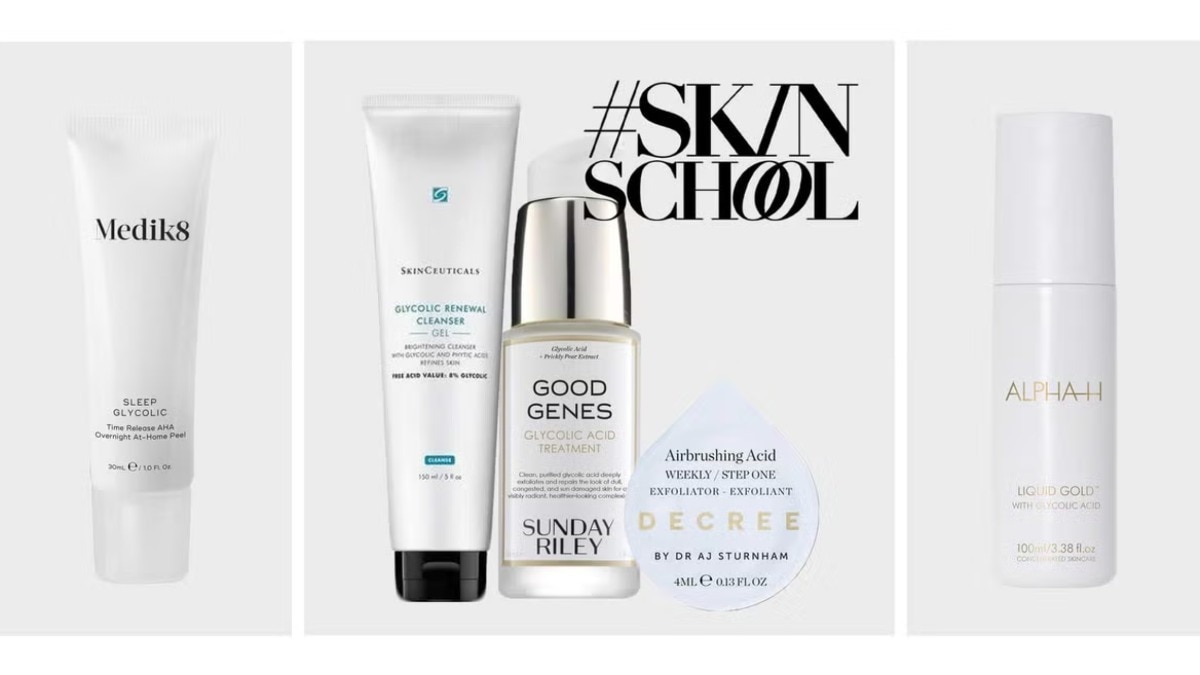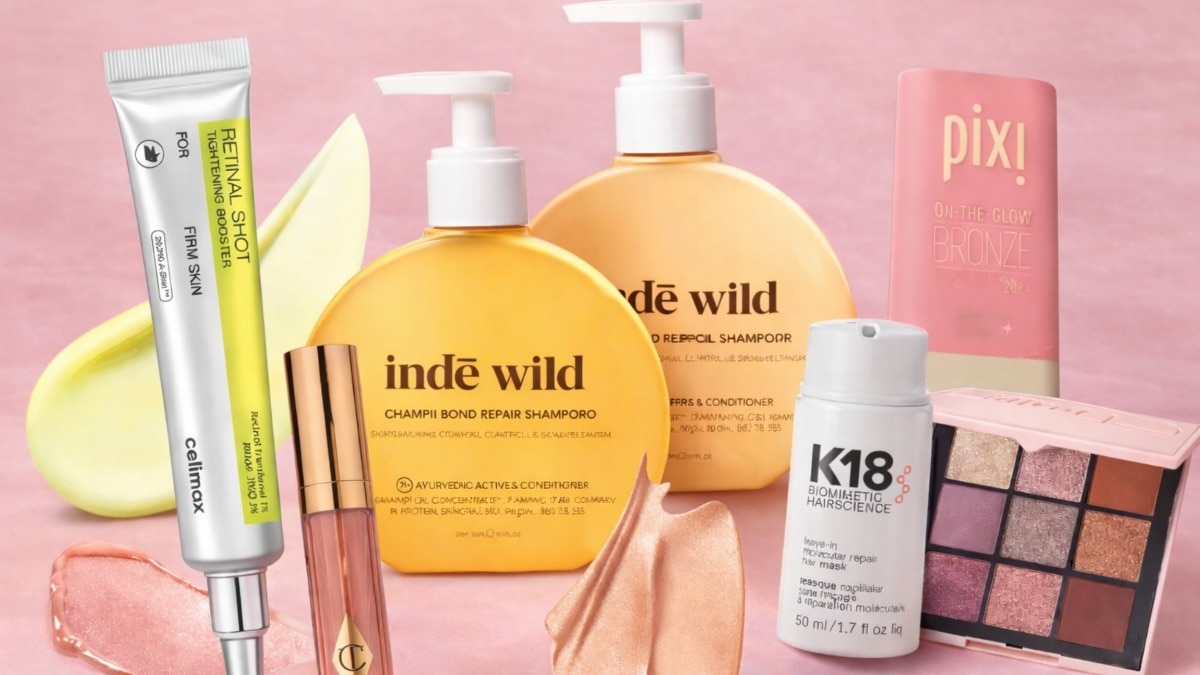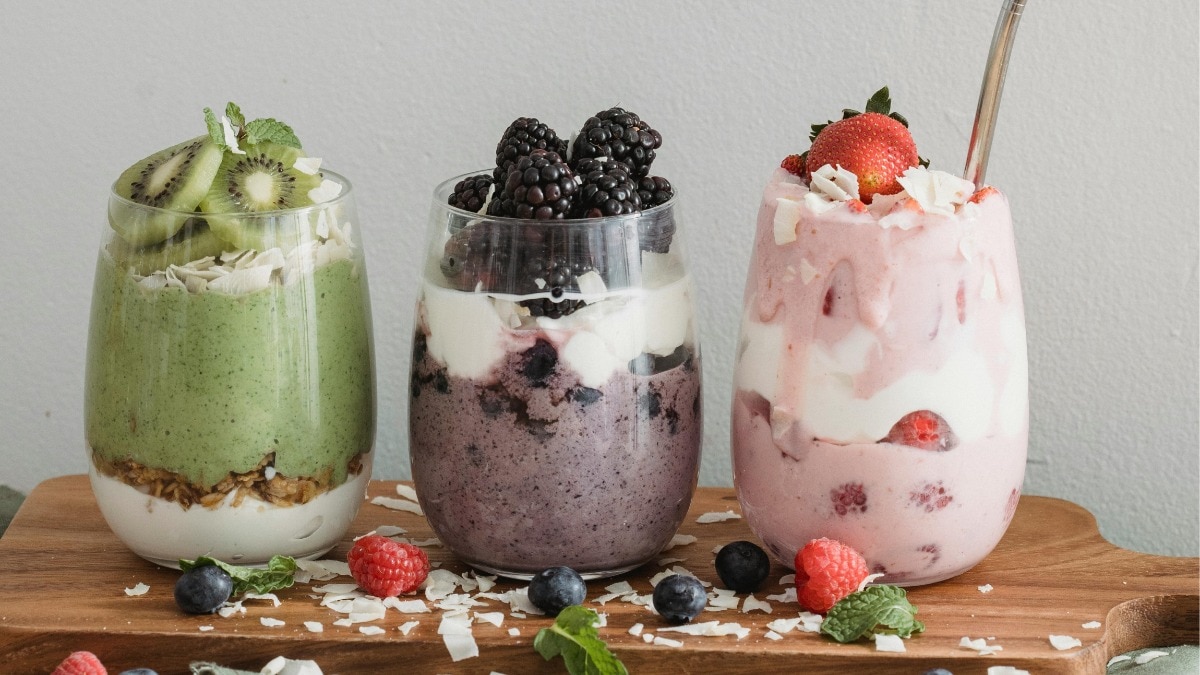
#SkinSchool: The best glycolic acid products, from toners to serums—and exactly how they work
Glycolic acid's brightening benefits are widely extolled, but you must use this active ingredient correctly. Here, the experts dig into the fine details.


Take a glance at the bottles on your skincare shelf: chances are, at least one of them contains glycolic acid. Perhaps several do.
Skincare harnessing this active ingredient has boomed in recent years, with demand for brighter, clearer complexions leading brands to funnel a dose of glycolic into everything from face washes to serums. But, as with all things in skincare, more doesn't always mean better. While the exfoliating, brightening, pigment-fading powers of this hard-working resurfacing compound are indeed formidable, incorrect or overzealous use of glycolic acid can wreak havoc with your skin barrier.
Here, the experts break down everything you should know about glycolic acid.
What is glycolic acid?
“Glycolic acid is a chemical exfoliating ingredient derived from sugar cane,” explains Dr Anita Sturnham, a GP specialising in dermatology and founder of skincare line Decree. "It is part of the alpha hydroxy acid (AHA) family, which also includes other well-known ingredients, such as lactic acid.”
Glycolic acid has the smallest molecules of all AHAs, enabling it to effectively penetrate the upper layers of the skin. This, however, means more sensitive types may find its resurfacing effects harder to tolerate.
Best glycolic acid products: the Bazaar top five
- The cleanser: Skinceuticals Glycolic Renewal Cleanser, £45
- The serum: Sunday Riley Good Genes Glycolic Acid Treatment, £70
- The toner: Alpha-H Liquid Gold, £43
- The at-home peel: Medik8 Sleep Glycolic, £38
- The acne treatment: La Roche-Posay Effaclar Serum, £31.20
What does glycolic acid do?
Glycolic acid, like other AHAs, acts on the surface layer of the skin, loosening and dissolving the ‘cement’ between dead cells. It therefore gently resurfaces skin without the need for scrubbing. This is why acid-based products are often referred to as ‘chemical exfoliators’, in contrast to traditional, grit-based ‘physical exfoliators’, which are now largely regarded as the inferior option due to their often abrasive nature.
“AHAs are water soluble, so they work well on the superficial skin layers, which we call the epidermis,” explains Dr. Sturnham. “Glycolic acid has been shown in studies to have dermal influence, boosting collagen-remodelling cells (which helps to reduce the appearance of fine lines and wrinkles), and melanocyte-stabilising properties, meaning it works well for pigmentation, too. It’s a versatile multi-tasker.”
As they get to work, you often feel a tingle in the skin, which is when the desmosome (the glue-like substance which holds old skin cells together) is broken down. "The skin then naturally sheds its old, dead skin cells. So, although you won’t actually see your skin exfoliating, you’ll soon see and feel the smoother textured, more radiant-looking skin."
How much glycolic acid is too much?
Where skincare acids were once approached with caution—especially outside of the confines of a clinic—many of us are now happy to experiment with different acid-based products. But despite the shelves being stuffed with various chemical exfoliators, from toners to serums and creams, good results only come from educated use.
According to Dr. Sturnham, the trend for ‘over-exfoliation’ is a big issue. “Many of the skin conditions that I see and treat in the clinic are self-inflicted because of this. So many people are obliterating their skin barriers with exfoliating cleansers, followed by exfoliating acid toners, acid serums, grains and scrubs in an attempt to create flawless tone and texture, but sadly this type of product strategy tends to make skin worse,” she warns.
In the EU, the amount of ‘active acid’ permissible in a home-use product is 10 per cent. “Anything claiming to have higher levels is likely to be buffered with an alkaline agent, which is quite misleading. Sometimes these are buffered to a level that leaves hardly any active acid at all,” says Dr. Sturnham. “Other skin-stimulating ingredients are added instead, such as menthol or peppermint, to make the skin tingle, so you feel like you are getting an acid exfoliation. Ten per cent is still a punchy dose, so you only need to do a deep-working acid treatment once a week.”
The skincare industry has clearly picked up on our ill-advised appetite for super-strength exfoliators, with countless glycolic-based products promising mega concentrations, with the implication that this will lead to equally mega results. However, when finding the best glycolic acid product for your skin, it’s not purely about the percentage of acid inside.
As Dr. Sturnham explains, the pH of the finished product plays just as important a role in determining its strength. “In terms of choosing your acid dose for your weekly treatment, the higher the concentration of acid and the lower the pH, the faster the keratolytic effect—meaning that the desmosome glue will break down quicker, speeding up shedding of old dead skin.”
To make matters more complex, another important factor is the Pka of the product, which the majority of brands don’t declare. “Pka is more specific and tells you the PH that the molecule needs to be to accept or donate a proton. The lower the Pka, the stronger the acid. I expect we will see this measurement included on products more and more over time.”
If this all sounds rather too much like a science lesson for your liking, know that all you really need is common sense: if a product stings or hurts, it's probably not doing your skin much good. An ephemeral tingling or slight flushing is likely fine, but pain is a sign something is wrong. Similarly, employ restraint, using your glycolic product sparingly, and you'll likely see excellent results.
How to use glycolic acid correctly
So the message is clear: when it comes to using glycolic acid products at home, less is more. Dr. Sturnham recommends using a gentle, low dose of exfoliating acid every evening; she suggests an AHA cleanser, although a glycolic acid toner also works well. If you prefer a more active treatment, such as a mask or pad, restrict it to once weekly.
What’s more, if you’re opting for a high-strength glycolic acid product, it’s crucial to replenish the skin after exfoliation. “I believe that no strong exfoliation of the skin should be performed without an accompanying mask that puts back conditioning actives into the skin,” says Dr. Sturnham, whose own Weekly Decree treatment comprises an exfoliating fruit-acid gel as well as a lipid-rich replenishing cream.
Finally, a leave-on serum can be a great way to reap the benefits of glycolic acid. Many can be used nightly, but if you're new to resurfacing products or have sensitive skin, it pays to start slow. Try incorporating your chosen product into your routine once a week to monitor how your skin reacts, and always use an SPF in the daytime (as acids can increase skin sensitivity to sunlight).
Here, see the glycolic acid products the Bazaar team trusts, from a cult toner to pro-level peels for dark spots.
The best glycolic acid products to try now
The glycolic acid cleanser
SkinCeuticals Glycolic Renewal Cleanser
A glycolic acid cleanser makes a good introduction to exfoliating acids, as the contact time with the skin is shorter than with a serum or cream.
You'll find this one on the shelves of many a Bazaar-approved clinic: effective without veering into extreme-strength territory, it'll tackle surface dullness as well as congestion. Introduce it into your routine a few evenings a week, and always wear a facial SPF by day.
If you're prone to breakouts, another great one to try is the Murad AHA/BHA Exfoliating Cleanser, which contains both glycolic and salicylic acids to treat surface debris and trapped oil.
The glycolic acid serum
Sunday Riley Good Genes Glycolic Acid Treatment
Sunday Riley’s eponymous brand is one to trust when it comes to effective actives. This creamy resurfacing face serum is one of her most widely loved, thanks to the way it works on a deeper level to dissolve debris and excess oil, leaving skin looking cumulatively brighter and unified.
When it comes to serums, your skin's tolerance to acids should determine how often you apply: a gentle tingle is ok, but a burning sensation is not ('no pain, no gain' doesn't apply in skincare). This one is fairly potent, so go slowly: a night or two per week should deliver optimal benefits.
The glycolic acid toner
Alpha-H Liquid Gold Exfoliating Treatment
Alpha H pioneered the use of glycolic acid in skincare products and, 25 years since its launch, the iconic Liquid Gold is still the brand bestseller.
This watery, toner-style treatment combines glycolic acid with liquorice to bolster the brightening effects, meaning it works especially well on pigmentation. A low pH and high acid percentage combine to make this one a stronger option for seasoned users. The brand recommends using every other evening, but those new to acids should limit to a once-weekly application to begin with.
The at-home peel
Medik8 Sleep Glycolic
Medik8's glycolic acid product is designed to mimic the effects of a brightening in-clinic peel. With a pH of 3.5, it contains a potent 10 per cent concentration of AHA, encapsulated to ensure gradual release into the skin, thus reducing any risk of irritation. This is a fantastic option for anyone that has built up a tolerance to glycolic acid, but don't exceed the recommended two-to-three applications per week.
The acne treatment
La Roche-Posay Effaclar Serum
Salicylic acid is the star ingredient in many a breakout treatment, but La Roche-Posay has coupled it with glycolic acid in this powerhouse clarifying serum. Designed to clear out congested pores swiftly but sensitively, this dermatologist-approved formula should be stashed under the sink of anyone battling adult acne or periodical breakouts.
The moisturising serum
Fresh Lotus Youth Preserve Resurfacing Dream Serum
A recent launch from Fresh, this milky serum balances the exfoliating properties of glycolic acid with prickly pear extract for mega hydration. As such, the light tingling feeling is mollified by moisture that lasts all night, leaving skin feeling plump and refreshed come morning. An ideal choice for anyone who wants equal parts exfoliation and hydration.
The weekly facial
Decree Weekly Decree
Based on Dr. Sturnham's belief that good acid treatments should replenish as well as exfoliate, this weekly mask involves two steps: a potent glycolic-steeped exfoliating gel and a creamy hydrating mask to replace the moisture and lipids that acids can strip from the skin. Brilliantly effective, you'll notice refreshed skin straight after use. Make it your once-a-week evening treat.
The texture smoother
Skin Design London The Retexturising Serum
Not just the aesthetician behind some of the best facials in London, Fatma Shaheen also creates some seriously effective at-home topicals within her Skin Design London brand.
Her texture treatment contains glycolic acid as well as retinol, meaning it's perfectly placed to steal the starring role in your routine. With niacinamide to build up the barrier and olive-derived squalene for hydration, it's a one-and-done remedy for rough texture, dark spots and fine lines.
The glycolic acid pads
Dr Dennis Gross Alpha Beta Ultra Gentle Daily Peel

These are the peel pads that started it all: loved by beauty insiders the world over, Dr. Dennis Gross’ Alpha Beta Peel sachets make light work of exfoliating dull skin. They now come in three degrees of strength, so you can work your way up to the level that most suits you.
However, we recommend starting with the Ultra Gentle iteration, whether you consider your skin to be sensitive or not. Simply swipe over cleansed skin to let the blend of five acids dissolve skin-clogging debris, then neutralise any lingering acid with the soothing second step.
The pigmentation serum
iS Clinical Brightening Complex
Sun spots are notoriously tricky to shift with topicals alone, but iS Clinical's high-strength serum is your best ally. A pigmentation serum with punch, it uses a cocktail of glycolic, salicylic and lactic acids to deal with existing surface pigmentation, alongside a supporting cast of antioxidants and anti-inflammatory extracts that control melanin synthesis to prevent new patches from developing.
The glycolic acid moisturiser
Kate Somerville ExfoliKate Glow Moisturiser
If a multiple-step skincare routine isn't for you, switch your basic moisturiser out in favour of Kate Somerville's active-charged formula every few evenings. From the acclaimed Exfolikate line, this cream contains fruit enzymes as well as glycolic and lactic acids to gradually slough away dull skin cells.
We also love the more potent KateCeuticals Resurfacing Overnight Peel, ideal for specifically counteracting lingering scars, dark spots, and other visible signs of sun damage.
The glycolic acid face mask
Révive Masque de Brilliance Resurfacing Multi-Acid Mask
This smart new launch from Révive is a one-and-done formula that'll transform skin in serious need of a reboot. Whether you're prepping for a party or simply recovering from a long week, this blend of multiple acids—salicylic for congestion, glycolic and lactic for surface texture—will smooth, brighten and unify in one fell swoop. With hyaluronic acid and peptides in the mix, it feeds the skin as well as it exfoliates, too.
The glycolic acid essence
Caudalie Vinoperfect Concentrated Brightening Glycolic Essence

Lighter than a serum, but still packed with actives, Caudalie's resurfacing essence will sink into just-cleansed skin to gently encourage cell turnover. It's created with pigmentation in mind, but works well on texture and overall congestion, too. Those with sensitive skin should get on fine here, but don't be tempted to apply every day—every other is ample.
The gradual brightener
Naturium Glycolic Acid Resurfacing Gel 10%

This reliable (if not that sexy) glycolic acid gel will gradually brighten and unify tone over the course of a few weeks. We'd recommend using it one evening a week, beneath a simple restorative night cream.
The glycolic acid body wash
Kosas Good Body Skin AHA + Enzyme Exfoliating Body Wash

Glycolic acid is ideal for use on the body—especially if you're tackling keratosis pilaris, back breakouts or lingering fake tan. Kosas' brilliant body wash smells subtly of white florals and foams up to sweep away dirt without drying out your skin.
The glycolic acid body lotion
Drunk Elephant T.L.C. Glycolic Body Lotion

Not just a great face exfoliator, glycolic acid is brilliantly effective on the body, too.
This lightweight lotion marries softening plant oils and coconut extracts with a punchy dose of glycolic acid, making it ideal for anyone prone to ingrown hairs, shaving spots or dry, scaly elbows.
The scalp treatment
Living Proof Scalp Care Exfoliator

Glycolic acid is a great ingredient to use on the scalp, as it'll help dislodge product build-up and excess oil from your roots. Use this deep-treatment liquid to sweep away the week's residue, leaving hair full of volume and movement.
This article originally appeared on Harper's Bazaar UK in August 2024.
Also read: An A-Z guide to kiss goodbye to your monsoon frizz
Also read: The latest beauty launches that you must add to cart










